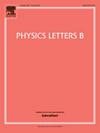Percolation of domain walls in the two-Higgs doublet model
IF 4.3
2区 物理与天体物理
Q1 ASTRONOMY & ASTROPHYSICS
引用次数: 0
Abstract
Domain walls formed during a phase transition in a simple field theory model with symmetry in a periodic box have been demonstrated to annihilate as fast as causality allows and their area density scales . We have performed numerical simulations of the dynamics of domain walls in the Two-Higgs Doublet Model (2HDM) where the potential has symmetry in two spatial dimensions. We observed significant differences with the standard case. Although the extreme long-time limit is the same for the sets of random initial configurations analyzed, the percolation process is much slower due to the formation of long-lived loops. We suggest that this is due to the build up of superconducting currents on the walls which could lead ultimately to stationary configurations known as Kinky Vortons. We discuss the relevance of these findings for the production of Vortons in three spatial dimensions.
求助全文
约1分钟内获得全文
求助全文
来源期刊

Physics Letters B
物理-物理:综合
CiteScore
9.10
自引率
6.80%
发文量
647
审稿时长
3 months
期刊介绍:
Physics Letters B ensures the rapid publication of important new results in particle physics, nuclear physics and cosmology. Specialized editors are responsible for contributions in experimental nuclear physics, theoretical nuclear physics, experimental high-energy physics, theoretical high-energy physics, and astrophysics.
 求助内容:
求助内容: 应助结果提醒方式:
应助结果提醒方式:


